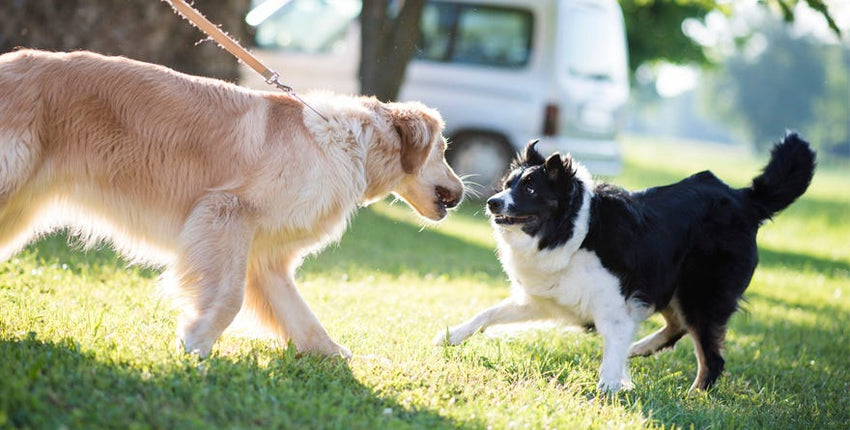Rough Play With Your Dog: What Is Appropriate?
Teaching your dog to play nicely without biting, jumping up on you, or otherwise playing too roughly doesn't have to be difficult. It does, however, require a foundation of obedience training. Not only will this training teach your dog the foundation obedience exercises sit, down, stay, come, and walk on a leash nicely but this training will help you both to communicate better with each other. Plus, as you learn how to teach your dog the basic obedience exercises, you will also be able to teach him additional things, including better behavior during play.
If you've already done some obedience training, think about a refresher course to fine tune your skills. If you haven't done some obedience training, talk to a local trainer about a basic obedience course. No matter what games you play with your dog, stop the game before your dog becomes so excited that he begins jumping, biting, or otherwise plays too rough. Watch his body language and actions to see if you can pinpoint when he crosses the line from acceptable play to over stimulated. Ideally, interrupt his play before he gets too excited. Stop the game, put a leash on him, ask him to lie down, and give him something to chew on. Or, if he's already too excited, walk him on the leash and ask him to do some obedience exercises until he calms down. Don't yell at him or otherwise punish him; that's counter productive. Instead, help him calm himself.
You can also prevent unwanted behaviors in other ways. Teaching him to do something that prevents him from doing the unwanted behavior is wonderful. For example, if your dog likes to grab your clothes or hands or just plain bites at you during play, teach him to grab one of his toys instead. As a general rule, this type of mouthiness isn't aggressive but instead is more like the type of play he might do with another dog. After all, dogs bite and chew on each other and one will let the other one know when the biting is too hard. People, however, don't appreciate being bitten no matter what the reason. And, of course, biting is unacceptable for many other reasons. So hand him a toy when he's playing and encourage him to hold on to it and play with it. With a toy in his mouth, he won't be biting or grabbing you.
Limit Rough Play Between Dogs and Children
I don't remember him but my folks had a German Shepherd Dog named Butch when I was a baby and toddler. I've seen him in photos; he was a sable, gray and silver, and handsome. By today's standards he was small but he was all heart; my parents said he was my playmate and protector. Although the idea of kids and dogs seem perfect, it works out only when the dog is patient and tolerant of children's antics, and when a parent supervises the dog and children.
Children need to know that they cannot play rough; wrestling, fighting type games with the dog as these encourage the dog to fight back. When play gets too rough, someone will get hurt. Chasing games aren't good, either, as the dog will then chase the child and try to catch him by grabbing or biting. Hide and seek games (let the child hide and encourage the dog to find him), find it games (hide toys or treats and encourage kids and dog to find them), and retrieving games are much better than rough games.
Until taught differently, your dog will play with your children as he did his littermates. Those games are rough, rowdy, wrestling games or chase and catch games; neither of which are appropriate for kids. That means you need to help your kids play better games with the dog and you need to supervise their playtimes.
Setting Boundaries for Your Young Dog and Old Dog
Many training class students tell me they got a new puppy or young dog to help keep their old dog active or in anticipation of the end of their older dog's life. Although some older dogs will play with the new puppy and enjoy it, as the older dog ages, he's going to want less playtime and more relaxation and peace. When your older dog wants to play, let him set the tone of the play. If the puppy or young dog is too rough and the old dog corrects him by pinning him, barking and growling, or otherwise telling him off; that's fine.
However, when your old dog gets tired and has had enough, help him stop the play. Move the puppy away, give them each something to chew on, take the puppy for a walk, or put the older dog in another room for a nap. As your puppy grows up and gets bigger and your old dog ages, run interference for him. Don't let the young dog get too rough and most importantly, don't let him pick on the old dog. My Bashir is 12 years old now and Bones is almost four. Thankfully, Bashir has taught Bones how to play and they don't play rough with each other at all. However, there are times when Bones will bring Bashir a toy, asking to play, and I can see Bashir is tired. So I call Bones aside and play with him so he doesn't continue to bother old Bashir.
Let Your Young Dog Learn From Other Dogs
Ideally, your puppy learned how to play when he was still with his mother and littermates. At this early age, he was ready and able to learn and if he bit too hard or was otherwise a bully he would be taught what he did young. A yipe, cry, or growl was good communication. Plus, a puppy who played too rough and didn't change would find himself alone; his littermates would, essentially, shun him for a short period of time.
Once he joins your household these lessons need to continue. He can play with your older dog at home or, once he has his vaccinations, with puppies in a puppy training class. Just be aware that even puppy play can get rough. There is chasing, barking, growling, grabbing of the neck or tail, and tug of war games with toys. Every growl and bite doesn't need your interference, however. Just watch the puppies as they play. If one puppy continues to cry or hides or tries to escape from the play area then you need to step in. Otherwise let them try and work it out. If there is a big size or age difference, then some guidance may be needed during the play. No one (big or small, old or young) is allowed to be a bully.
Rough Play With Adult Dogs
Bashir has been playing with other dogs all his life. Although he normally plays with dogs his size (50 pounds) or larger, one of his best friends is half his size. When he plays with this friend, Walter, Bashir has to change his playing style and does. Rough play is tempered and Bashir makes sure not to run into his smaller friend. Lessons like these are learned during play. When both dogs were younger, if Bashir ran into or over Walter, the smaller dog would get mad and chase Bashir with flashing teeth and snapping jaws. Bashir learned. However, if Bashir got too excited or too rough I might also speak up, "Bashir, easy!" Or, rarely, I would have Bashir come to me and lie down and relax for a few minutes.
Adult dogs who were well socialized as puppies and had good experiences playing with other puppies will be more likely to continue to have good play skills as adults. However, if the dog didn't have good play experiences when younger, he may never be able to enjoy playing with other dogs. It's hard, if not impossible, to make up for the lack of those experiences. In situations such as these, keep your dog happy with human play rather than forcing unwanted canine play.

